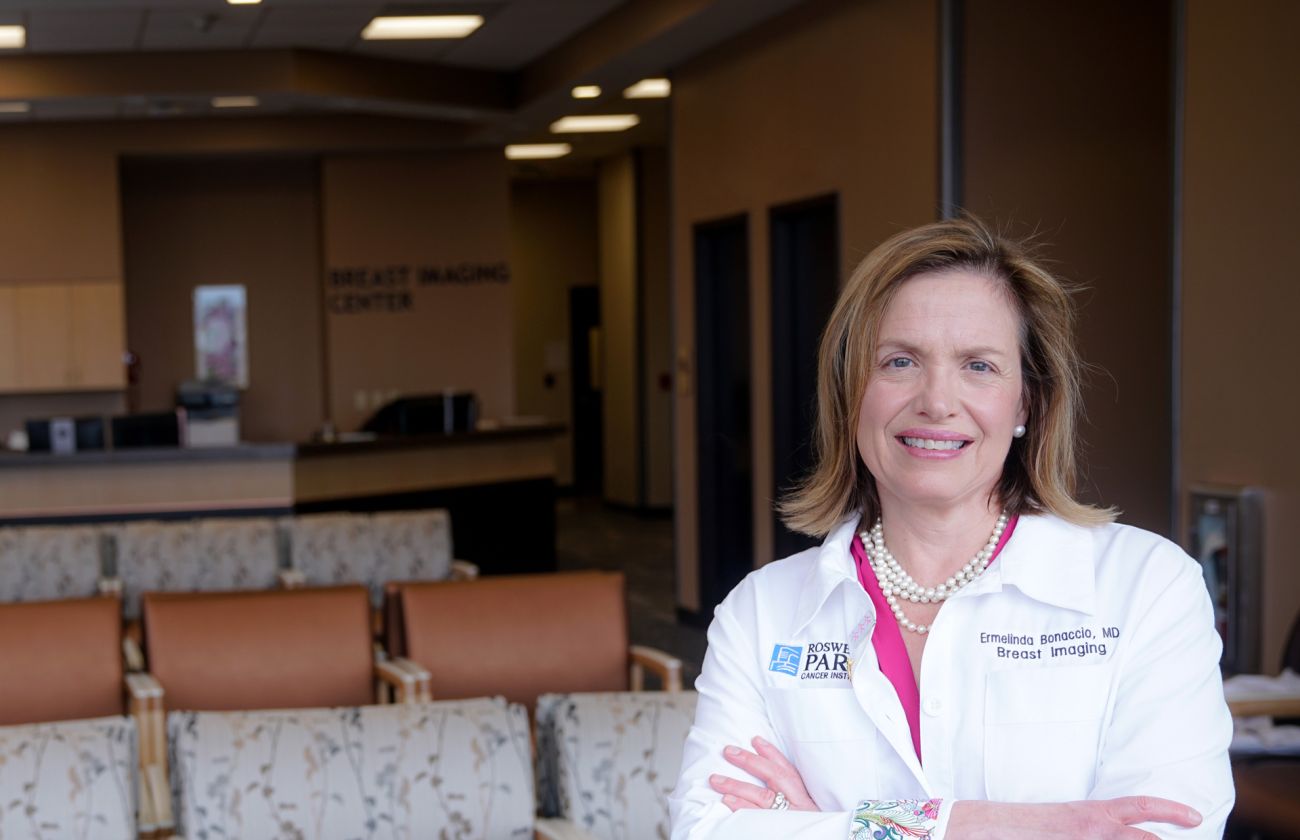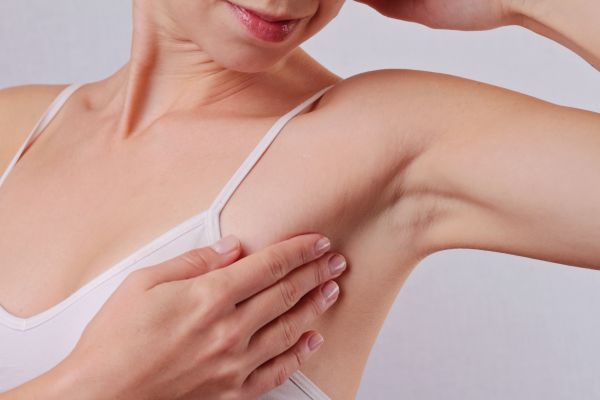Do I need a screening mammogram?
According to Ermelinda Bonaccio MD, FACR, Chair of the Department of Diagnostic and Interventional Radiology at Roswell Park Comprehensive Cancer Center, the unfortunate truth about breast cancer is that the average American woman has a one in eight chance that she will develop it in her lifetime. Research suggests yearly mammograms are the best way to detect breast cancer early.
Here is a guide to everything you need to know about screening mammograms.
The National Comprehensive Cancer Network (NCCN) recommends that women of average risk begin annual mammograms at age 40. Roswell Park follows these guidelines.
Every year.
No, a baseline mammogram at age 35 is not necessary. The first mammogram that a woman has at age 40 serves as her baseline mammogram.
Yes, however your breasts may be tender so you may feel more discomfort than normal.
Yes — caffeine has no effect on mammograms, but sometimes it can make women’s breasts more tender.
Yes! Women with breast implants should follow the same rules for mammograms: get one annually, starting at age 40. When making an appointment, you should mention that you have implants.
Yes, however we typically do not perform screening mammograms on pregnant women. If the patient has a lump or other abnormality of concern, we start with an ultrasound and then do a mammography as needed.
Yes, however breast tissue can be very dense during lactation, which can make the images harder to read. Most providers recommend nursing or pumping right before the appointment. The X-rays used during a mammogram will not make the milk unsafe for the baby. Women who are breastfeeding should mention this to their provider when scheduling an appointment
What to expect during your mammogram appointment
Before your appointment, you will receive a reminder with a link to an online history form.
You do not need a prescription for a mammogram in New York State, but if you do have one, remember to bring it to ensure your primary doctor will receive the results.
When you arrive at your appointment, the mammography staff will check you in and make sure your paperwork is complete.
When you are called back for your mammogram, you will remove all clothing and jewelry from the waist up and change into a gown that opens in the front. In the imaging room, the technologist will ask you to stand next to the mammogram machine and remove one arm from the gown. The technologist will position your breast on a flat plate and lower another plate to compress your breast tissue. This part may be uncomfortable, but the time in compression is very short.
Roswell Park offers the latest digital 3D mammography technology, which uses less compression than was necessary in the past to obtain high quality mammogram pictures.
When your breast is in place, you will be asked to hold your breath for a few seconds while the technologist takes the mammogram. The plates are then repositioned to take a second image of that same breast. This process is then repeated on the other side.
The technologist will check that the images clearly show both breasts. Once the images are approved, you will then get dressed and proceed to check out.
The paperwork will then be brought back to the radiologists, who read the mammograms. Mammogram screening results are typically available within one business day.
Wear something comfortable. You will be asked to undress from the waist up.
You may bring someone to your appointment, but that person won’t be allowed into the imaging room.
Most women feel discomfort during the actual X-ray process. The pressure on your breasts from the equipment can cause pain or discomfort, but this part doesn’t last long. Your pain level will depend on your personal pain tolerance, the size and shape of your breasts, and where you are in your menstrual cycle.
Yes, you can wear deodorant on the day of your mammogram appointment.
In the past, patients were asked not to wear deodorant to their appointments because deodorant ‘artifact’ could be confused with breast calcifications — Roswell Park has the latest 3D mammography imaging technology with tomosynthesis, which clearly differentiates deodorant ‘artifact’ from breast calcifications.
A 3D scan takes a series of X-rays of the breast from different angles, then creates a three-dimensional image of the breast. The breast is positioned and compressed the same way as a conventional 2D mammogram. Studies have shown that 3D screenings detect more early-stage invasive breast cancers than 2D mammography alone.
“With a 2D screening, if there's a question of overlapping breast tissue, the patient will need to come back in for additional mammogram pictures. With the 3D screening, instead of having to repeat images for overlapping tissue, we often can see it clearly on the first set of images,” Dr. Bonaccio says. “A 3D mammogram allows us to scroll through a mammogram like flipping through the pages of a book. It also adds another layer of confidence that you can scan through the tissue and see that there is no underlying mass.”
Learn more about the differences between 2D and 3D mammography.
Mammograms do expose the breast to very small doses of radiation during the X-ray. Studies have shown that the benefits from regular mammograms far outweigh the risk.
The time you will spend in the breast imaging center for a screening mammogram is typically between 30 and 45 minutes. The mammogram itself typically takes about 10 minutes. The breast is compressed for typically five to twenty seconds per image.
Most screening results are available the day of the appointment.
Most screening mammograms — performed on patients with no symptoms — are normal. If you are called back from your screening mammogram for a diagnostic imaging appointment, there is still a good chance that your mammogram will be read as normal after taking additional pictures. If your mammogram is read as abnormal, the radiologist will recommend a breast biopsy procedure called a core-needle biopsy. Core-needle biopsies are performed in the office with local anesthesia. The results from the biopsy recommendation could still be benign (a false positive).
“Mammogram screenings with tomosynthesis (3D) detect approximately five to seven breast cancers per 1,000 women screened,” says Dr. Bonaccio. “The radiologist reading your mammogram may be able to estimate how suspicious the finding is at your diagnostic appointment.”
If your breast biopsy results show atypical cells or breast cancer cells, the radiologist will refer you to a breast surgeon at Roswell Park.
The American College of Radiology (ACR Accreditation) is the gold standard in medical imaging. Their statistics show that out of every 100 women who get a screening mammogram, 90 of them will be told it is normal, and 10 will be asked to return for additional imaging. From these 10 women, six will be reassured that their mammograms are normal, two will be asked to return in six months for a follow-up, and two will be recommended to have a core-needle biopsy.
Most insurance providers include an annual screening mammogram free of charge. In New York State, there is no copay for screening mammography
You can get a mammogram with the experts at Roswell Park without a prescription or referral. There are two locations, one in downtown Buffalo on Roswell Park’s main campus, and one in Williamsville at Breast Care of WNY.
How do I know if I am high risk for breast cancer?
There are some factors that increase your risk of breast cancer that you can’t change. These include being a woman, older age, race, family history of breast cancer and genetics. And there are risk factors that you can change that may decrease your risk of breast cancer, such as maintaining a healthy body weight, moderating your alcohol intake, exercising routinely and not smoking.
Check your risk level with our breast cancer risk assessment form
No, it does not matter which side of the family has a history of breast cancer. You inherit genetic material from your mother and your father, so it is important to know your family history on both sides of the family.
Your risk increases the more relatives that have been diagnosed with breast cancer, regardless of which side of the family they are on. If there is a history of breast cancer, your healthcare provider should perform a risk assessment. If your family history is significant, or meets certain criteria, it may be recommended that you begin screening at an earlier age, or that you get genetic testing to see if you are at risk for hereditary breast cancer
Most women who develop breast cancer do not have a family history of breast cancer. That is why we recommend screening mammography for all average risk women beginning at age 40.



